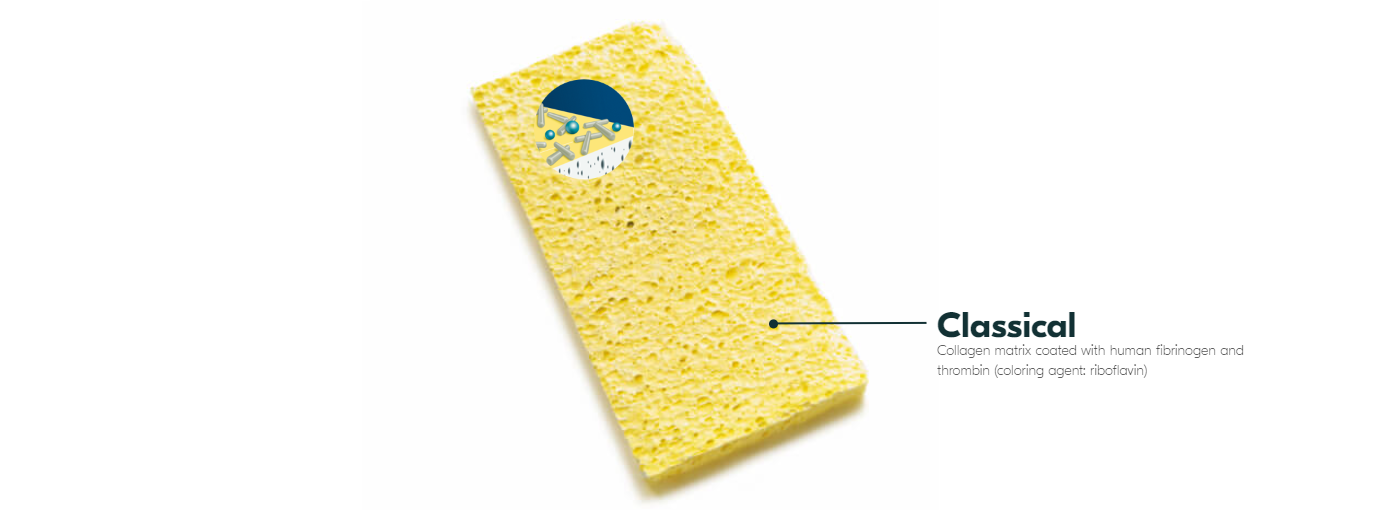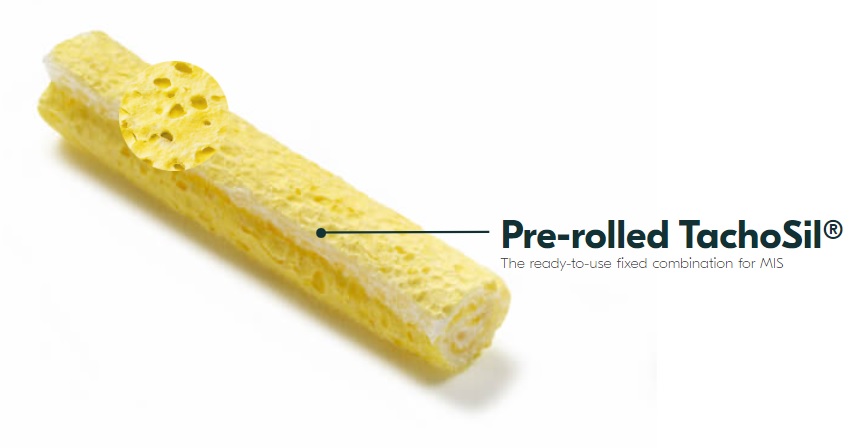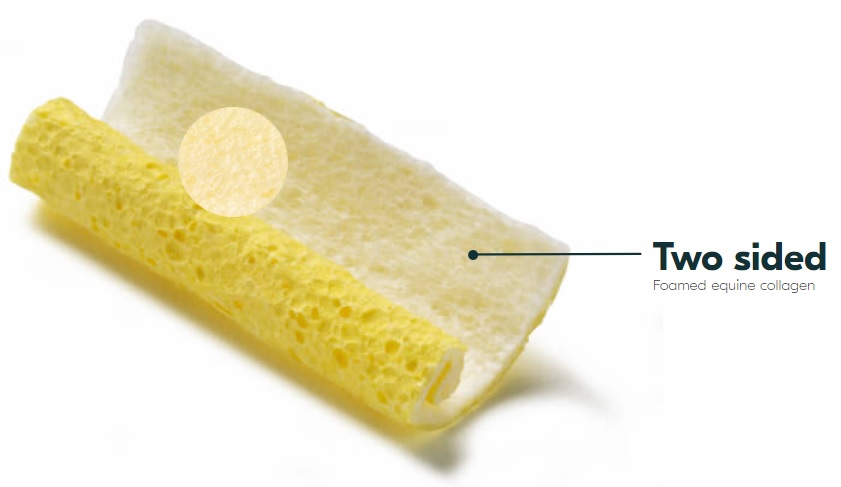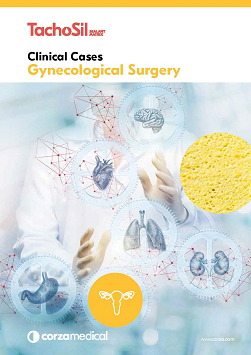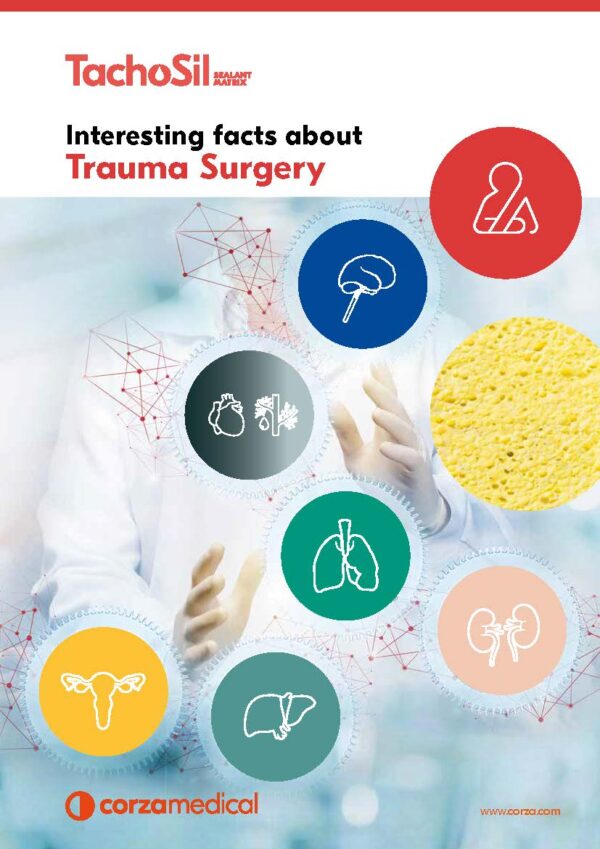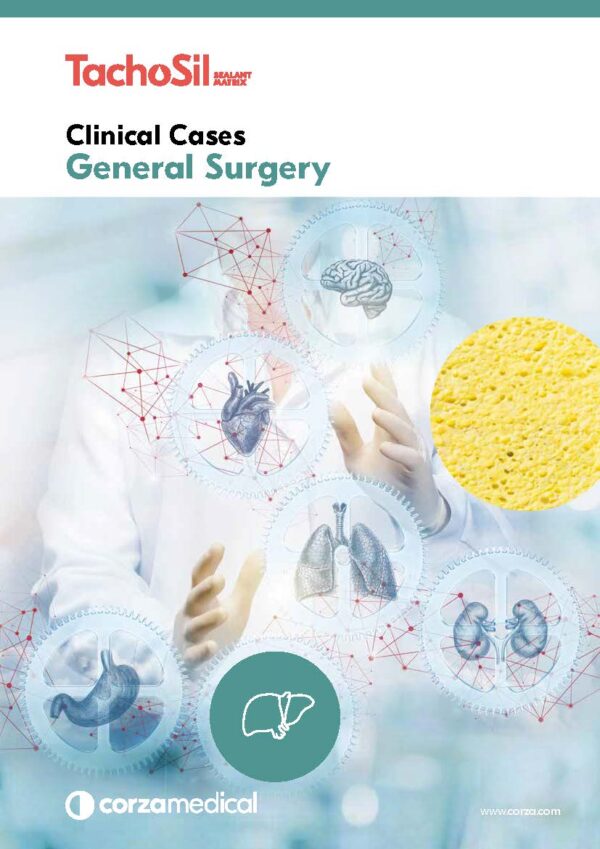TachoSil Sealant Matrix
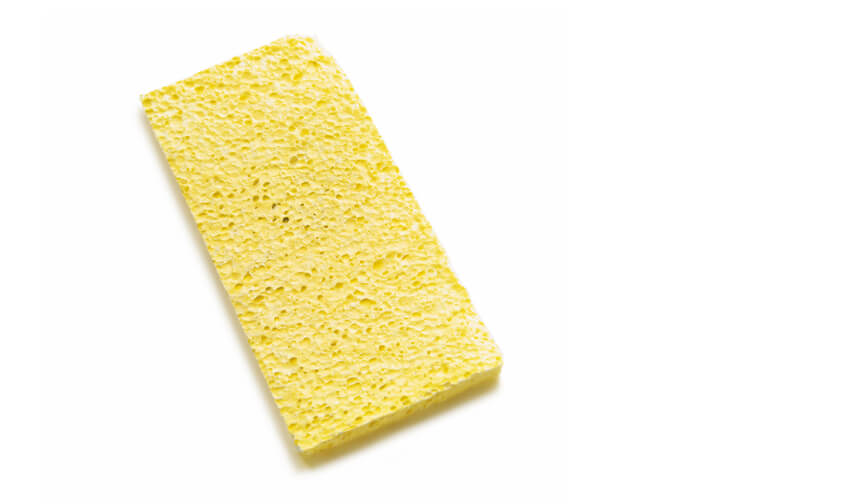
What is TachoSil®?
TachoSil® sealant matrix is a collagen patch coated with physiologic coagulation factors. It has unique mechanical, hemostatic, and occlusive properties and can therefore be used in a wide range of open and minimally invasive surgical procedures. With fibrinogen and thrombin¹, TachoSil® mimics the last part of the physiologic coagulation cascade. Hemostasis and sealing in one – with proven efficacy and safety.
Who are we?
As a new surgical company, we at Corza Medical are very proud to further develop and market TachoSil®, an established product acquired from Takeda Pharmaceuticals. We believe TachoSil® is an essential addition to our portfolio and to our mission to support the surgical community with outstanding products.
*The first product of the TachoFamily, TachoComb® (human fibrinogen, bovine thrombin, and aprotinin), was launched in 1992 in Austria. TachoSil®, a further development of TachoComb®, was launched in 2004.
How is TachoSil Made?
TachoSil® is manufactured in Linz/Austria since 2004 (under brand TachoComb since 1992). As best-in-class hemostatic and sealant patch that is trusted by medical professionals worldwide, the entire pharmaceutical manufacturing process is carried out in class C cleanrooms.
After taking over marketing and distribution by acquisition of all assets and licenses that support the development and commercialization of TachoSil® globally by Corza Medical, Takeda manufactures TachoSil® for Corza Medical since 2021.
We invite you to take insights of our high quality manufacturing process that respect highest safety standards in the video below.
The efficacy of TachoSil® at a glance:
Improves hemostasis
Promotes tissue sealing
Supports sutures in vascular surgery
Supports sealing of the dura mater
*Not all sizes and formulations of TachoSil® are available in all markets.
The mode of action of TachoSil®
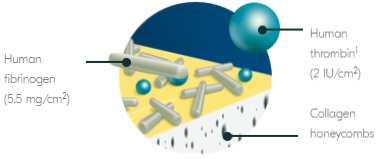
The reliable partner
for hemostasis & sealing
TachoSil® is a ready-to-use fixed combination of a collagen matrix coated with the active human coagulation factors fibrinogen and thrombin¹.
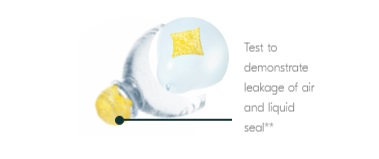
Can reduce air
and liquid leakages²
TachoSil® collagen matrix consists of 5–8 honeycomb layers.
How to apply TachoSil®
1

Open aluminum blister
The cover film can be removed outside the sterile zone.
2

Open plastic blister
Peel off the cover film in the sterile zone with sterile gloves.
3

Grasp
Remove the fleece from the sterile packaging with forceps.
4

Trim (optional)
Important: TachoSil® should extend 1-2 cm beyond the edge of the wound.
5

Moisten (optional)
If the wound is dry, moistening before application is recommended. If the wound is wet, TachoSil® can be dry when applied.
6

Apply
Apply with the yellow active side facing the wound. If multiple fleeces are used, overlap them like roof tiles.
7

Press in place
Press in place slightly for at least 3-5 minutes, ideally with a moist compress.
8

Remove the compress
Remove carefully, using forceps if necessary.
The biological degradation of TachoSil®

after 4 weeks
The collagen patch is completely coated with serosa containing dense connective tissue with blood vessels among the mesothelial cells.

after 12 weeks
The patch is increasingly absorbed by granulation tissue.
TachoSil® in general and abdominal surgery
Clinical publications and further literature
Safety & Efficacy
1. Frilling A et al. Effectiveness of a new carrier-bound fibrin sealant versus argon beamer as haemostatic agent during liver resection: a randomized prospective trial. Langenbeck’s Arch Surg 2005; 390:114-120
2. Broelsch CE et al. TachoSil® as haemostatic treatment in hepatic surgery. HPB 2005;7(Suppl 1):28
3. Maisano F et al. TachoSil® surgical patch versus conventional haemostatic fleece material for control of bleeding in cardiovascular surgery: a randomised controlled trial. Eur J Cardiothorac Surg 2009; 36:708-14
4. Siemer S et al. Efficacy and safety of TachoSil® as haemostatic treatment vs standard suturing in kidney tumour resection: A randomised prospective study. Eur Urol 2007; 52:1156-1163
5. Marta GM et al. TachoSil® versus standard surgical treatment for air leakage in pulmonary lobectomy. 16th European Conference on General Thoracic Surgery Bologna, Italy, 8-11 June 2008. Interact Cardiovasc Thorac Surg 2008; 7(Suppl 2):S19
6. Anegg U et al. Efficiency of fleece-bound sealing (TachoSil) of air leaks in lung surgery: a prospective randomised trial. Eur J Cardiothorac Surg. 2007; 31:198-202
7. TachoSil® EMA SmPC, September 2021
8. Haas S. The use of a surgical patch coated with human coagulation factors in surgical routine: a multicenter postauthorization surveillance. Clin Appl Thromb Hemost 2006; 12:445-50
9. Anegg U et al. Do the benefits of shorter hospital stay associated with the use of fleece-bound sealing outweigh the cost of the materials? Interact Cardiovasc Thorac Surg 2007;doi:10.1510/icvts.2007.162677
10. Lang G et al. Efficacy and safety of topical application of human fibrinogen/thrombin-coated collagen patch (TachoComb) for treatment of air leakage after standard lobectomy. Eur J Cardiothorac Surg 2004;25:160-6
11. Erdogan D et al. Evolution of Fibrinogen-Coated Collagen Patch for Use as a Topical haemostatic Agent. Journal of Biomedical Materials Research Part B: Applied Biomaterials 2008;85:272-8
12. Erdogan D et al. Adhesive strength of fibrinogen-coated collagen patch or liquid fibrin sealant in an experimental liver resection model in pigs. Eur Surg Res 2008;41:298-302
Liver
13. Apestegui C et al. Control of Severe Portal Bleeding by Carrier-Bound Fibrin Sealant. Surgery Today 2009; 39: 363–365
14. Briceño J et al. A Prospective Study of the Efficacy of Clinical Application of a New Carrier-Bound Fibrin Sealant After Liver Resection. Arch Surg 2010; 145: 482–48
15. Droghetti A et al. Prospective randomized trial comparing completion technique of fissures for lobectomy: Stapler versus precision dissection and sealant. J Thorac Cardiovasc Surg 2008; 136: 383–391
16. Fischer L et al. Haemostatic efficacy of TachoSil in liver resection compared with argon beam coagulator treatment: An open, randomized, prospective, multicenter, parallel-group trial. Surgery 2011; 149: 48–55
17. Frena A et al. How to improve biliostasis in liver surgery. Chirurgia Italiana 2006; 58: 793–795
18. Frilling A et al. Effectiveness of a new carrier-bound fibrin sealant versus argon beamer as a haemostatic agent during liver resection: a randomised prospective trial. Langenbecks Archive of Surgery 2005; 390: 114–120
19. Lempa M et al. Blutstillung mittels TachoComb® während laparoskopischer Cholezystektomie bei Leberzirrhose. Minimal invasive Chirurgie 2000, 9: 107–109
20. Mehrabi A et al. Transplantation of a severely lacerated liver – a case report with review of the literature. Clin Transplant; 2009: 321–328
21. Mirza D et al. The Use of TachoSil® in Children Undergoing Liver Resection With or Without Segmental Liver Transplantation. Eur J Pediatr Surg 2011; 21: 111–115
22. Toro A et al. TachoSil®: Use in abdominal surgery – A review. Journal of Blood Medicine 2011; 231–236
23. Toti L et al. Reduction of bile leaks following adult split liver transplant using a fibrin-collagen sponge: A pilot study. Digestive and Liver Disease 2010; 42: 205–209
24. Zentai C et al. Fibrin patch in a pig model with blunt liver injury under severe hypothermia. J Surg Res 2014;187: 616–624.
Preclinical publication
25. Erdogan D et al. Adhesive strength of fibrinogen-coated collagen patch or liquid fibrin sealant in an experimental liver resection model in pigs, Eur Surg Res 2008; 41: 298–302
Pancreatic
26. Chirletti P et al. Pancreaticojejunostomy with Application of Fibrinogen / Thrombin – Coated Collagen Patch (TachoSil®) in Roux-en-Y Reconstruction after Pancreaticoduodenectomy. J Gastrointest Surg 2009; 13: 1396–1398
27. Hüttner FJ et al. Effectiveness of Tachosil(®) in the prevention of postoperative pancreatic fistula after distal pancreatectomy: a systematic review and meta-analysis. Langenbecks Arch Surg. 2016 Mar;401(2):151-9.
28. Kleeff J et al. Distal Pancreatectomy – Risk Factors for Surgical Failure in 302 Consecutive Cases. Annals of Surgery 2007; 245: 573–582
29. Mita K et al. Pancreaticojejunostomy Using a Fibrin Adhesive Sealant (TachoComb®) for the Prevention of Pancreatic Fistula Following Pancreaticoduodenectomy. Hepato-Gastroenterology 2011; 58: 187–191
30. Montorsi M et al. Efficacy of an absorbable fibrin sealant patch (TachoSil) after distal pancreatectomy: a multicenter, randomized, controlled trial. Ann Surg 2012; 256: 853–859
31. Müller MW et al. Gibt es Indikationen für eine Pankreassegmentresektion. Chirurgische Praxis 2006; 66: 199–208
32. Sa Cunha et al. Prevention of pancreatic fistulae by application TachoSil® patch after distal pancreatectomy. A phase III open study. Abstract presented at the 8th French-speaking congress on GI and hepato-biliary surgery, 2012
33. Padillo J et al. Human Fibrinogen Patches Application Reduces Intra-Abdominal Infectious Complications in Pancreas Transplant with Enteric Drainage. World J Surg 2010; 34: 2991–2996
34. Pavlik MI et al. Effect of TachoSil patch in prevention of postoperative pancreatic fistula. J Gastrointest Surg. 2011 Sep;15(9):1625-9. doi: 10.1007/s11605-011-1584-9.
35. Pozzo G et al. A New Method of Jejunal Reconstruction after Pancreaticoduodenectomy. Hepato-Gastroenterology 2010; 57: 1305–1308
36. Silvestri S et al.Role of TachoSil® in distal pancreatectomy: a single center experience. Minerva Chir. 2015 Jun;70(3):175-80.
GI
37. Carbon RT et al. Innovative Surgical Management of NEC–Results of 52 Consecutive Cases.
38. 7th World Congress on Trauma, Shock, Inflammation and Sepsis. Munich, March 13–17 2007, Medimond International Proceedings, Bologna, 29–44
39. De Stefano A et al. Enteric Anastomosis and TachoSil®. Minerva Chirurgica 2011; 66: 183–188
40. Di Carlo I et al. Use of a Fibrinogen- and Thrombin Coated Collagen Patch for Peptic Ulcer Perforation Repair. Hepato-Gastroenterology 2009; 56: 575–577
41. Parker C et al. The application of TachoSil® for sealing colorectal anastomosis: a feasibility study. Colorectal Dis 2013; 15: 252–257
42. Schopf SK et al. Observations on the use of TachoSil® in Cholecystectomy – a multicentre, prospective, single-arm cohort study. Zentralbl Chir 2012; 137: 55–60
43. Toro A et al. TachoSil®: Use in abdominal surgery – A review. Journal of Blood Medicine 2011; 231–236
The TachoSil® Product Family
TachoSil® comes in a double sterile package. The folding box contains the package leaflet and an aluminium composite foil container. Air and thus moisture are kept out by this heat-sealed aluminium foil. This ensures that fibrinogen and thrombin do not react with each other prematurely and the full adhesive strength remains until it is applied.
TachoSil® is available in four different versions and three sizes.*
*Not all sizes and formulations of TachoSil® are available in all markets.
How can we help you?
Who can I contact if I have additional questions?
Please click here to contact Corza Medical for all your questions, comments, medical information inquiries, or suggestions.
Who can I contact if I need to report an adverse event?
Please use one of the following contacts if you wish to address a medical information request, a complaint or pharmacovigilance topics.
MedInfo: medinfo@corza.com
Complaints: quality@corza.com
Pharmacovigilance: Corza-Safety@iconplc.com
How can I order?
Please click here to find the order contact details for your country.
Will the terms and conditions stay the same?
Yes, the terms and conditions under which the Corza sealant patch products have been supplied to you by Takeda will remain unchanged until such terms and conditions are either terminated or renegotiated.
Where can I find the Summary of Product Characteristics?
Please click here to see the Summary of Product Characteristics.
Finding everything you need?
Our team of product specialists and sales representatives are here to help you find what you need. Let’s get you connected with a team member today.
References
1. Summary of Product Characteristics TachoSil® sealant matrix, current status
2. Haas S. Clin Appl Thromb Hemostat 2006;12(4): 445–450. 3 Maisano F et al. European Journal of Cardio-thoracic Surgery 2009; 36: 708–714.
3. EMA.europa.eu (25.08.2021)
** An air and liquid-tight seal with TachoSil® sealant matrix can be demonstrated using simple tests on a water bottle and balloon.
TachoSil® sealant matrix (coated with human fibrinogen and human thrombin)
PRESCRIBING INFORMATION
Refer to Summary of Product Characteristics (SmPC) before prescribing.
Presentation: An off-white sponge coated with human fibrinogen 5.5 mg and human thrombin 2.0 IU per cm2. The active side of the sponge is marked by a yellow colour. Supplied, ready to use, in sterile packaging. Indications: In adults and children from 1 month old, for supportive treatment in surgery for improvement of hemostasis, to promote tissue sealing, and for suture support in vascular surgery where standard techniques are insufficient; also in adults for supportive sealing of the dura mater to prevent postoperative cerebrospinal leakage following neurosurgical procedures. Dosage & Administration: For epilesional use only. Use is restricted to experienced surgeons. The number of sponges to be used is governed by the size of wound area, and the underlying clinical need for the patient. In clinical trials the individual dosages have typically ranged from 1–3 sponges. Sponges should be used under sterile conditions and immediately after opening the inner sterile cover. Prior to application, the wound area should be cleansed, e.g. from blood, disinfectants and other fluids. The sponge should be pre-moistened in saline solution and applied immediately. The yellow, active side of the sponge is applied to the bleeding/leaking surface and held against it with a gentle pressure for 3–5 minutes. Pressure is applied with moistened gloves or a moist pad. If covered with blood, surgical instruments and gloves may be pre-moistened with physiological saline solution to avoid the sponge sticking to them. After pressing the sponge to the wound, the glove or the pad must be removed carefully. To avoid the sponge from being pulled loose it may be held in place at one end, e.g. with a pair of forceps. In the case of stronger bleeding, it may be applied without pre-moistening, while also pressing gently to the wound for 3–5 minutes. The sponge should be applied so that it extends 1–2 cm beyond the margins of the wound. Sponges should be overlapped if more than one is used and can be cut to the correct size and shaped if too large. Any unused medicinal product or waste material should be disposed of in accordance with local requirements. Contraindications: Intravascular use; hypersensitivity to the active substances or to any of the excipients. Warnings & Precautions: No specific data available on the use of this product in gastrointestinal anastomosis surgery. Allergic type hypersensitivity reactions are possible, as with any protein product. If hypersensitivity reactions occur, the administration must be discontinued immediately. In the case of shock, the current medical standards should be followed. Standard measures to prevent infections from products prepared from human blood or plasma include selection of donors, screening of individual donations and plasma pools for specific markers of infection and the inclusion of effective manufacturing steps for the inactivation/removal of viruses. Measures taken are considered effective for enveloped viruses such as HIV, HBV and HCV and for the non-enveloped virus HAV. Measures may be of limited value against non-enveloped viruses such as parvovirus B19. Parvovirus B19 infection may be serious for pregnant women (foetal infection) and for immunodeficient patients or those who have increased erythropoiesis e.g. hemolytic anaemia. Risk of transmission of infective agents cannot be totally excluded, including pathogens of hitherto unknown nature. It is recommended to record the name and the batch number of the product administered to the patient. Interactions: No formal interaction studies have been performed. In comparable products or thrombin solutions, the sealant may be denatured after exposure to solutions containing alcohol, iodine, or heavy metals. Fertility, pregnancy & lactation: Safety use in human pregnancy or breastfeeding has not been established. Only administer to pregnant and breastfeeding women if clearly needed. Undesirable Effects: Hypersensitivity or allergic reactions (in rare cases these reactions may progress to severe anaphylaxis; some cases of product residue causing granuloma); thromboembolism may occur if unintentionally used intravascularly, and adhesions and intestinal obstruction when used in abdominal surgery. Refer to the SmPC for details on full side effect profile and interactions. Marketing Authorisation Holder: Corza Medical GmbH, Speditionstrasse 21, 40221 Düsseldorf, Germany. Marketing Authorisation Numbers: EU/1/04/277/001-005.
Date of revision of the text: March 2023
Detailed information on this medicinal product is available on the website of the European Medicines Agency (EMA) http://www.ema.europa.eu/
